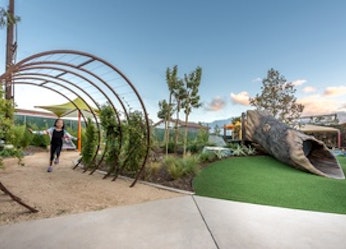Sep 23, 2016
Green building continues to be the wave of the future. In fact, when the Greenbuild International Conference and Expo hits Los Angeles next month, it's estimated to bring up to 25,000 environmentally focused minds together to discuss everything from the most recent LEED rating systems, one of the leading drivers for sustainability and energy efficiency in the nation, to new offerings such as SITES, WELL, GRESB and BREEAM.
There are numerous forward-thinking initiatives that showcase next-generation green technologies and design strategies. For example, projects like the Bullitt Center have achieved a Living Building status by striving for net-zero water and energy use. Showcase projects like this are adding green education and sustainability to their core marketing messages. Likewise, leveraging another standard called WELL building, some hotel chains in resort destinations are now selling out "stay well" rooms, featuring citrus-infused showers, circadian lighting and healthy snacks. Additionally, institutional investors are compiling portfolios of green assets and using the GRESB Assessment tool to evaluate and classify their sustainability efforts.
Sorting through the standards
With the continued adaptation of sustainability into building codes and so many third-party rating systems, how does one decipher which level of green to strive for with a new or existing investment? Which rating systems are most cost effective or provide the most value and return on investment? Which green programs have a strong brand recognition that coincides with marketing internal green policies or goals?
In some states new construction building codes, such as the International Green Construction Code and CALgreen, now fully integrate sustainability and efficiency, making it a baseline mandatory requirement. For new Class A office buildings, LEED and EnergyStar certifications are among the most common and provide marketability to differentiate from other buildings in the area. For existing buildings, which comprise the majority of building square footage in the U.S., building commissioning or retro-commissioning can be implemented to identify energy-saving strategies and capital improvement.
Green tools you can use
Unfortunately, green-building rating systems are notoriously challenging to keep up with, and depending on the climate location and holding strategy of an investment, it can be difficult to know which system to choose and how to begin implementing it.
While sorting through all options for green building can be overwhelming at first, there are plenty of informative websites, design professionals, and software available for performing energy modeling and scoring. With the adoption of benchmarking energy use during the building transactions in cities like New York City and San Francisco, using tools like Energy Star portfolio manager and third-party rating systems will continue to push green to the next level. Here are some additional green building resources:
LEED v4: Will continue to be used for state and federal government buildings, office buildings and warehouses.
Energy Star: Certification, benchmarking and soon-to-come waste tracking—all used in office buildings and retail. Includes
Fannie Mae loan incentives and portfolio manager to measure energy use compared to local averages.
GRESB: Utilized in national investment funds and portfolios.
WELL: Building standard applied to interior office spaces and hotels.
Living Building: Certification and Petals program are often used in high-profile educational-type buildings and single-family residential.
Asset Score: DOE tool typically used to model and report a building's energy use.
Ready to embrace the sustainable-building trend but not sure where to start with a new or existing property investment? Marx|Okubo's engineers and sustainability experts can help you weigh the pros and cons when deciding where and how to go green.
Photos courtesy of Carlos Hernandez from Studio 111








